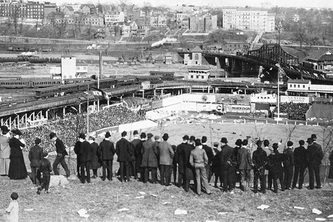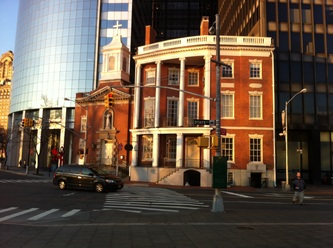While New York prepares for Superbowl Sunday in a particularly special way this year, here at Old New York we’ve been doing a little bit of “tackling” ourselves. Football, as we know it or American Football as it is more commonly known throughout the world, has a history all its own. Although Football had gained popularity in the Midwest as early as the 1800s there was one game in particular, a precursor to The Superbowl, that skyrocketed its fan base. Where was that game played, you might ask? Well folks, it was New York City!
“The Greatest Game Ever Played”
This 26th annual NFL championship game (not yet quite the Superbowl) was the first championship game to go into sudden death overtime. The Baltimore vs. New York game played at Yankee Stadium in 1958 marked the beginning of NFL’s infamy. Televised via NBC this championship game gave football the spike it needed to peak widespread interest. By 1965 football was carrying the ball and became the most popular televised sport in America. The star studded, big bucks Superbowl that we enjoy today has deep roots competing in a difficult field.
American Football
American Football is a culmination of rugby, association football (soccer) and Walter Camp, who is considered the “Father of American Football”. The innovative game changers that Camp introduced, such as the now-standard offensive line up and the points system, are just two unique aspects of football that Camp has been accredited with. A medical student at Yale, Camp played college football from 1876 to 1882, although he graduated in 1880. Even though it was not his primary trade, which was running his family’s business, he remained active and served as a head coach first at Yale and then at Stamford from 1892 until 1895. Not quite the sport it is today, Camp began the development of what has become a global interest. Inducted into the College Football Hall of Fame in 1951, Camp remained on various football rules committees until his death in 1925 helping to develop this truly American Sport.
Football Fumbles
Although professional baseball had already taken off with soaring popularity within the 1800s, football initially lacked the coordination and financial backing of the major leagues. Early on, college football was the main venue for the unique sport. That slowly began to change in 1920 with the founding of the American Professional Football Conference. Soon after its creation the APFC changed its name to the National Football League in 1922. The NFL was comprised of representatives of professional American football leagues and independent teams. It wasn’t until 1933 that an official tradition of a championship game ending the season began. The “blue laws” had also put a damper on football earlier on. Prohibiting alcohol specifically but also commerce on Sundays due to religious observation, the blue laws included football games in the ban, which baseball games had been excused from. It would take some time but football has emerged as a sport as well as an industry.
“We’ve Come a Long Way Baby”
The New York Brickley Giants, only a namesake to the New York Giants of today, were one of the first 17 professional teams to represent NYC at one time or another. Founded in 1919 by Charles Brickley, also known as The Brickley Giants or Brickley’s Brooklyn Giants, this team was, unfortunately, not destined for greatness. Created in 1919, the team played only one season in 1921 and lost their only two games 55-0 and 17-0. Brickley was considered quite the college football player and owned a baseball team, also called The New York Giants. The second shortest lived franchise in NFL history, The Brickley Giants could not compare to The New York Giants we know today. Joining the NFL in 1925, The New York Giants are the only team admitted that year to still exist. With seven NFL titles, the teams ranks third among all NFL franchises. In December of 1930, The New York Giants played against the Notre Dame All Stars at the Polo Grounds in New York City to fund-raise money for the unemployed and also to help the image of the sport. With two touchdowns and Notre Dame failing to score it was a hands down win, raising $100,000.00 (remember it’s 1930) for charity and scoring credibility for the sport itself.
“History Hidden in Plain Sight”
The Polo Grounds where the Giants won the infamous game against Notre Dame were comprised of four stadiums located between 110th street and 112th streets between 5th and Lenox Avenues in Upper Manhattan. The original stadium built in 1876 was originally intended for Polo games which were short lived. The following three stadiums enjoyed many baseball and football games from 1880 until 1963. Although the Polo Grounds, as they were collectively named, are long gone there is still a part that remains. The “John T. Brush Stairway” which runs between Edgecombe Avenue and Harlem River Drive at 158th Street is still visible. Named for the one time owner of The Giants (the original baseball team), it is a (partially) buried treasure. Opened in 1913 the stairway led to a ticket booth overlooking the stadium. It is said that the ticket booth offered a clear view of the stadium for fans that had not purchased tickets, perhaps even the best in the house! Gone to disrepair this historic stairway is undergoing renovation with monies donated from The New York Football Giants, Jets, Yankees, Mets, San Francisco Giants and Major League Baseball. It is scheduled to be re-opened as an historic site September of this year.
As the New York Giants take part in the spotlight this year it is worthy to note all of the game changers, players and events that have brought us to the Superbowl XVLI!
Go New York Giants!
Forgive us, New Englanders, after all we are New Yorkers.









 RSS Feed
RSS Feed